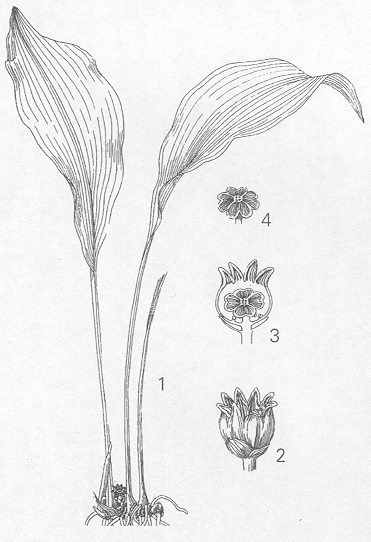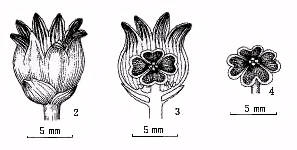.
Aspidistra sichuanensis
| Accepted name | Aspidistra sichuanensis K. Y. Lang & Z. Y. Zhu. Acta Bot. Yunnanica, 6(4): 387, fig. 1. (1984). |
| Synonyms | |
| Distribution | China * Forests, bamboo forests, thickets; 500-1100 m. Guangxi (Jinxiu Yao Zu Zizhixian, Napo Xian, Xing’an
Xian), Guizhou (Anlong Xian, Zunyi Xian), W Hunan (Yongshun Xian, Zhijiang Xian), Sichuan, Yunnan (Kunming Shi). (from Flora of China) |
| Description | Rhizome: creeping, terete, diameter 6 - 12 mm. Leaves: solitary to ca. 70 cm; cataphylls undescribed; petiole 10 - 35 (- 40) cm; lamina sometimes with yellowish white spots, lanceolate to elliptic-lanceolate, 20 - 35 cm long x 4 - 8 cm wide. Peduncle: 0.5 - 5 cm long; flowers solitary. Perianth [Perigone]: subcampanulate; tube brown-purple inside, purple outside, 7 - 9 mm long x 0.9 - 1.5 cm diameter [see notes]; lobes (6 -) 8 recurved, purple-red, deltoid-lanceolate, 3 - 6 mm long x 2 - 3 mm wide, adaxially 4-keeled, keels densely papillose. Stamens: (6 -) 8, inserted proximally in perianth tube, subsessile. Pistil: Table-shaped; style columnar, short, developed at the top into a peltate, orbicular, stigma, 0.8 - 1.2 cm in diameter, slightly convex centrally, 4-ridged, (3 -) 4 (- 5)-lobed at margin, lobes emarginate at apex. Fruit: berry tuberculate. Phenology: flowers & fruits January - March. 2n = 38 (from Flora of China & personal observations) |
| References | Flora of China |
| Comments | The FoC gives the dimensions of the perigone tube as "7–9 x 0.9–1.5 cm", this should be 7 - 9 mm long x 0.9
- 1.5 cm diameter. Image of Aspidistra sichuanensis from Li 2004 copied directly I think from Lang & Zhu 1984.
Image of Aspidistra sichuanensis from Lang et al 1999. Plants labelled as Aspidistra sichuanensis are available in the trade but most I think are another species. Plants I am growing that I think are Aspidistra sichuanensis were imported from China labelled Aspidistra elatior and Aspidistra lurida. This illustration of Aspidistra sichuanensis is from and is a re-drawing of the illustration in Lang & Zhu 1982. It shows the stigma as an essentially flat structure with four indented lobes, rather like a four-leaved clover. This is rather misleading. |


